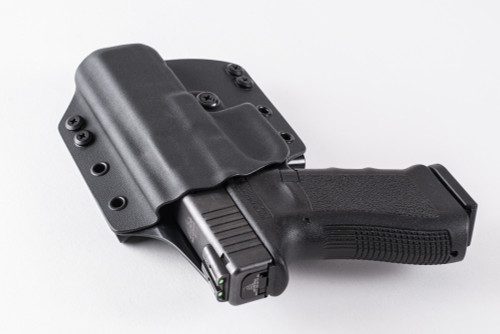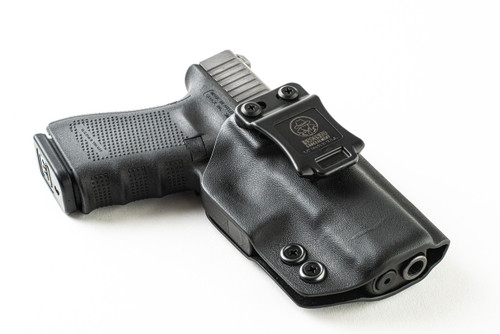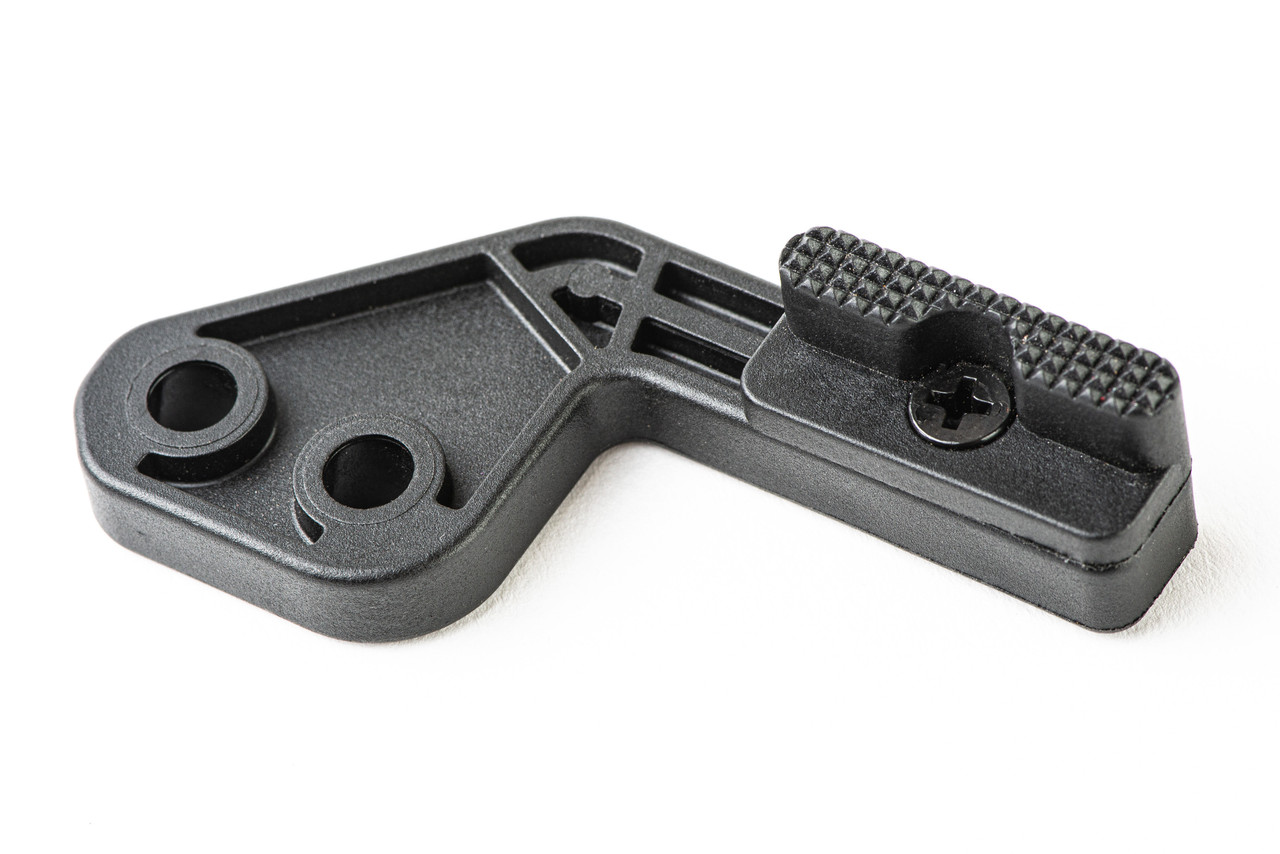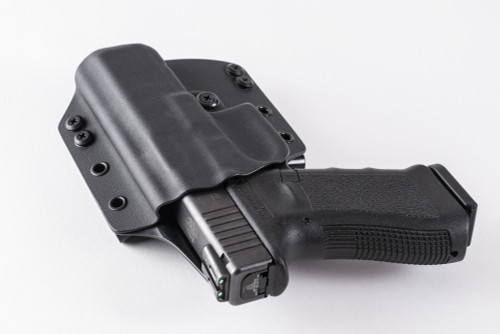Concealed Carry Tips: Determining Your Best Holster Position
Oct 29th 2023

One of the most critical aspects of concealed carry is determining the position and orientation of your holster relative to your body. Even if you have already decided what handgun you’d like to carry, choosing a carry position and a matching holster can be challenging.
Your preferred combination of gun, holster, and belt position must provide the ideal balance of concealment, comfort, and ease of access. Follow these concealed carry tips to find the best holster position for your needs and preferences.
What Makes a Good Concealed Carry Holster Position?
In concealed carrying, the holster position refers to the position and orientation of a holster on a traditional gun belt. While there are other carry methods, such as ankle carry, pocket carry, or off-body methods, carrying a CCW handgun in a holster on a gun belt is the most common and one of the safest choices.
A quality gun belt and durable holster provide maximum retention for your handgun, ensuring it safely remains on your body with minimal risk of dropping or losing it.
The position of your concealed carrying holster is made up of multiple elements working together to provide a balance of concealment, comfort, and ease of access to your gun. Understanding how each part of the position works and how it can affect your holster’s effectiveness is crucial to deciding the best one for you.
Carry Style
The carry style refers to the holster’s position relative to the waistband.Belt-mounted holsters fall into two general categories: inside the waistband (IWB) and outside the waistband (OWB).
The first decision to make is deciding whether to carry IWB or OWB. Your choice will influence the type of holster you can carry, as well as the clothing to wear for concealment.
- IWB Carry. IWB carry places the gun and holster on the inside of your waistband, meaning your pants must accommodate your body, holster, and gun comfortably. Carrying IWB may require a wardrobe adjustment to avoid discomfort, such as sizing up your pants. However, it also enables deeper concealment than OWB, provided your handgun is small enough to prevent printing.
- If worn correctly, you can conceal an IWB holster with only a shirt or a similar cover garment, which you can tuck over your gun and holster. A fully concealed IWB holster should not print through your shirt and be almost impossible to detect, with only a belt clip attached to your gun belt in plain view.
- OWB Carry. OWB carry means wearing a holster riding outside your pants’ waistband. This carry style doesn’t require changing your wardrobe, maximizing comfort and convenience. Because the constraints of your waistband do not limit you, OWB is also suitable for carrying larger handguns and corresponding holsters.
- The primary drawback of OWB carry is needing additional layers of clothing to conceal your holster. While many OWB holsters feature slim profiles designed for concealment, you must wear at least one cover garment over it to keep your gun hidden. Because of this, local climates or dress codes may limit concealment effectiveness.

Belt Position and Clock Notation
When wearing a belt-mounted gun, concealed-carrying enthusiasts use a clock notation system to refer to the holster’s position on the belt. The notation was designed to prevent confusion regarding the left and right sides or dominant and non-dominant hands.
To understand the clock notation system, picture a traditional clock on the floor with your body standing in the center. For example, 12 o’clock corresponds to the direction directly in front of you; wearing a holster 12 o’clock means it rides on the front of your belt.
Typical belt positions and corresponding clock notations include strong-side hip carry, behind-the-hip carry, appendix carry, cross-draw carry, and small-of-the-back carry. Here’s how each position works and concealed carry tips for each one.
- Strong-side Hip Carry. Carrying strong-side means the holster rides on your belt over one of your hips. The term “strong-side” refers to the side of your body corresponding to your dominant hand. For right-handed shooters, the strong side is 3 o’clock. Left-handed shooters have their strong side on the 9 o’clock position.
- Wearing a strong-side holster is the traditional carry position. It is a recommended starting point for beginners because it provides high comfort and ease of access. While concealment can be good, larger handguns may be more likely to print because they stick out of your body.
- If your body type is on the larger side, consider a modified strong-side hip carry with your handgun at the 2 o’clock position (or 10 o’clock if left-handed). It will place your gun ahead of the hip, taking advantage of your natural curves for concealment while maintaining reasonable comfort and access to your weapon.
- Behind-the-Hip Carry. Although it may appear similar to hip carry at first glance, this carry position has an extra benefit; it can offer more concealment than strong-side hip carry by hiding your gun behind your hip. The trade-off makes your gun slightly harder to access, as you have to reach behind you to grip and draw.
- As with strong-side hip carry, the holster is carried on the side corresponding to your dominant hand. If you are right-handed, the holster is between 4 and 5 o’clock. If left-handed, 7 to 8 o’clock instead.
- Appendix Carry. Carrying appendix means placing your holster at or around the 12 o’clock position, roughly over the pelvic area. Some shooters may prefer a slight offset to the left (11 o’clock) or right (1 o’clock), depending on whether they are right or left-handed.
- Appendix carry is suitable for pairing an IWB holster with a large handgun. Some IWB holsters are designed for appendix carry, known as Appendix IWB (AIWB) holsters.
- It provides a high degree of comfort and has excellent concealment but requires additional care and diligence. Carrying a gun appendix has the muzzle potentially pointing at your crotch or thigh, meaning an accidental discharge can have serious consequences.
- If you have a slender body type, appendix carry can be a better first choice for concealment than strong-side hip carry. It allows you to conceal a handgun using the broadest side of your body, especially if you find your handgun prints or protrudes too much on your hip.
- Cross-Draw Carry. Cross-draw carry is a variant of strong-side hip carry that places the holster on the side opposite your dominant hand. However, instead of wearing the holster on your other hip, you wear it in front of the hip, closer to your front.
- Right-handed shooters will place a cross-draw holster in front of their left hip at about 10 o’clock. Left-handed shooters will do the inverse, wearing it on the right hip at roughly 2 o’clock.
- At first glance, cross-draw carry may seem counterintuitive because your hand has to travel a longer distance than with standard strong-side hip carry. However, it can be one of the most comfortable carry positions if you remain seated for extended periods, such as in a car or an office.
- Cross-draw goes as far back as the Old West; cowboys of the era found it easier to draw a handgun on horseback from cross-draw. It also kept the hip free of anything that could snag on objects on the ranch.
- Small-of-the-Back (SOB) Carry. Carrying a gun in the small of your back means placing your weapon and holster at the 6 o’clock position. In theory, it offers the same concealment and comfort benefits as appendix carry but without the risks associated with a muzzle pointed down and at your body.
- However, SOB carry is not recommended because it is also considered a safety risk. Wearing a firearm and holster in the 6 o’clock position places a gun directly behind your spine. It increases the risk of a severe injury if you fall on your back during a confrontation or a self-defense situation.
Ride Height
A gun holster’s ride height refers to how high or low it sits relative to your belt and waistband. Even if you find the proper belt position, adjusting your ride height can help you gain more concealment or ease of access to your weapon.
Ride heights are categorized into three groups: high, low, and mid-ride.
- High-ride. A high-riding holster places your trigger guard above your gun belt and presents the rear of your grip higher. On IWB holsters, a high-ride maximizes ease of access to your weapon. However, it can compromise concealment if not paired with the right gun, belt position, and cant angle.
- On OWB holsters, a high ride can improve concealment because it lets you wear shorter shirts and cover garments. However, it can limit the practical size of your handgun; larger handguns are more likely to print in a high-riding OWB holster.
- Low-ride. A low-riding holster places your handgun’s trigger guard below the gun belt. It is an ideal choice for maximizing concealment with an IWB holster because it hides more of the gun and holster inside your pants. However, it can bury the grip deeper, making it harder to reach.
- Low-riding holsters are not recommended for OWB carry because they are the least suited for concealment. This particular combination is typically found in duty and retention holsters because they facilitate access to the handgun, especially full-size models.
- Mid-ride. Mid-ride holsters place the gun’s trigger guard at about the same level as your gun belt. On IWB holsters, it offers a compromise between the concealment of a lower ride height and the ease of access of a higher one.
- On OWB holsters, you may prefer a mid-ride model if you carry a larger handgun. The top of the gun is less likely to print in a mid-riding holster than a high-riding one. However, ensure your cover garment is long enough to cover the bottom of your holster.
Cant Angle
The cant angle of a gun holster refers to the rotational angle of the holster relative to the floor. Adjusting your cant angle rotates your gun, which can help you improve concealment, comfort, and ease of access.
Cant angles are grouped into three categories: neutral, positive, and negative.
- Neutral Cant. A neutral or vertical cant has a rotational angle of 0°, making the barrel of your handgun perpendicular to a flat floor. It is traditionally paired with strong-side hip carry and OWB holsters because they offer maximum ease of access and excellent comfort.
- They are also the traditional option for appendix IWB carry because it is the least likely to point the barrel at one of your thighs. However, it may not offer the best concealment or ease of access to your gun with other carry positions.
- Positive Cant. A positive cant tilts the gun forward, causing the barrel to point slightly behind you. Positive cant angles can improve comfort and ease of access with behind-the-hip carry. It can also help you reduce printing with strong-side hip carry, particularly if you have a mid-sized handgun.
- The FBI cant is a specific positive cant angle, usually between 10° to 20° and paired with behind-the-hip carry. It was designed to maximize comfort and ease of access with the agency’s service pistols.
- Negative Cant. A negative cant tilts the gun rearward, making the barrel point slightly ahead of you. While negative cant angles are not recommended for traditional carry methods like strong-side or behind-the-hip, other positions can become more effective with them.
- For example, you can improve ease of access when appendix-carrying with a mild negative cant (about 5-10°). If you carry cross-draw, a stronger negative cant angle (22.5° or higher) can make it much easier to draw your handgun, especially from a seated position.

Additional Accessories
If you’ve found a carry position you like but want to boost its concealment, common concealed carry tips recommend using additional accessories. Examples include magazine carriers, mod wings, and wedges.
- Magazine Carriers: A magazine carrier is a belt-mounted pocket for a spare magazine. While their primary purpose is to allow you to carry extra ammunition, mag carriers can also serve as counterweights to enhance concealment.
- If you carry strong-side or behind-the-hip, your gun and holster can cause your belt to sag down slightly, making it more obvious you’re carrying. Carrying loaded magazine carriers on your belt, opposite of your gun and holster, can combat the sagging effect by distributing weight more evenly.
- Mod Wings: A modification wing, also known as a mod wing or claw, is a plastic accessory you can attach to your holster. The wing or claw-shaped element protrudes outward, pushing against the inside of your pants’ waistband to prevent your handgun from tipping forward and printing.
- Due to the way they function, mod wings are only necessary with IWB holsters.They can make it easier to conceal full-sized handguns.
- Wedges: A wedge is a triangular piece of foam designed to be installed inside an appendix IWB holster. When inserted correctly, it pushes the slide of your gun so the muzzle points away from your body and the rear is oriented inward.
- Wedges serve a similar purpose to mod wings; they help reorient the gun so the grip doesn’t tip forward and print. You can use a wedge alone or combined with a mod wing for extra concealment..
Find The Ideal Concealment Holsters and Accessories with Incognito Concealment
At Incognito Concealment, we aim to equip American citizens with the highest-quality concealment holsters, gun belts, magazine carriers, and other everyday carry (EDC) accessories.
We carry an extensive selection of IWB and OWB holsters for hundreds of handgunmodels. Contact us today to learn more about our holsters and accessories, or browse our blogfor more concealed carry tips.











